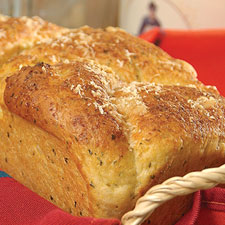Polenta Asiago Bread
One of Italy's great contributions to the world of food is its ability to take humble ingredients to new heights. Polenta is a perfect example. Coarse ground cornmeal is cooked with milk until it reaches a thick, creamy texture. It's then finished with cheese and herbs to make a delicious side dish that enhances any food it's paired with. Polenta's rich golden texture reminds us of captured sunshine. In this case it's the foundation of a tender bread that's just the ticket for that late summer, ultimate local tomato sandwich. Or fill 2 slices with a Mediterranean version of our beloved American BLT: arugula, prosciutto, and tomato.

Hands-on: 60 min to 1 hr 20 min | Bake: 25 min to 30 min
Total 1 hr 25 min to 1 hr 50 min | Yield: 1 loaf, 16 slices
Ingredients
Polenta
- 1/2 cup coarsely ground cornmeal (polenta)
- 1/2 cup cold water
- 1 cup milk
- 1 teaspoon salt
Dough
- All of the cooked polenta, cooled to lukewarm
- 1/2 cup water
- 2 teaspoons instant yeast
- 2 tablespoons olive oil
- 2 1/4 cups King Arthur Unbleached Bread Flour
- 3/4 cup freshly grated Asiago cheese
- 2 tablespoons dried parsley, or 1/4 cup chopped fresh
- More grated cheese to garnish the top
Instructions
Polenta
- In a medium saucepan, combine the cornmeal and cold water, stirring until the cornmeal is evenly moistened. Stir in the milk and salt, and place the pan over medium-high heat. Cook, stirring frequently, until the mixture thickens and bubbles. Continue cooking for 5 to 7 minutes more, until the mixture pulls away from the sides of the pan. Remove from the heat and set aside to cool to lukewarm.
Dough
- In the bowl of a mixer combine the cooled polenta, water, yeast and olive oil, stirring until the mixture is smooth.
- Add the flour, cheese, and parsley, and mix until a soft dough forms. You can also combine the ingredients in the order listed above in the pan of your bread machine set on the dough cycle. Press start and let the machine complete the cycle, checking the dough's consistency after 2 minutes of kneading time, adding a tablespoon more flour or water if necessary to adjust it.
- Knead the dough for 6 to 8 minutes, until it's smooth and springy. Place the dough in a greased bowl, cover with greased plastic wrap, and let rise until doubled, about 45 minutes.
- After the dough has risen, deflate it and divide it in thirds. Roll each piece to a rope about 10 inches long. Braid the dough, pinching the ends together to seal them and tucking them under the loaf. Place the braid in a lightly greased 9 x 5-inch loaf pan. Cover with lightly greased plastic wrap or a large inverted bowl, and let rise until the dough is an inch above the rim of the pan; about 30 to 45 minutes, depending on the warmth of the room.
- After 20 minutes of rising time, preheat the oven to 375 degrees F.
- When the loaf is ready to bake, remove the covering and sprinkle the top with more grated asiago cheese.
- Bake for 25 to 30 minutes, until the center measures 190 degrees F when measured with an instant-read thermometer.
- Remove the bread fro the oven and place the pan on a rack to cool for 15 minutes.
- After 15 minutes, turn the bread out of the pan and return it to the rack to finish cooling completely before slicing.
Notes
Tips from our bakers: Traditionally, dry polenta is sprinkled into simmering liquid, while whisking constantly. While effective, the technique requires some dexterity to avoid making lumps. A more surefire way to make smooth polenta is to wet the cornmeal with some of the recipe's cold liquid before proceeding.
Nutrition
Per 1 slice, 61g Servings Per Batch: 16: Calories 125 Calories from Fat: 34 Total Fat: 4g Saturated Fat: 1g Trans Fat: 0g. Cholesterol: 25mg Sodium: 205mg Total Carbohydrate: 18g Dietary Fiber: 1g Sugars: 1g Protein: 5g
* The nutrition information provided for this recipe is determined by the ESHA Genesis R&D software program. Substituting any ingredients may change the posted nutrition information.
Attribution
Recipe and photo used with permission from: King Arthur Flour

